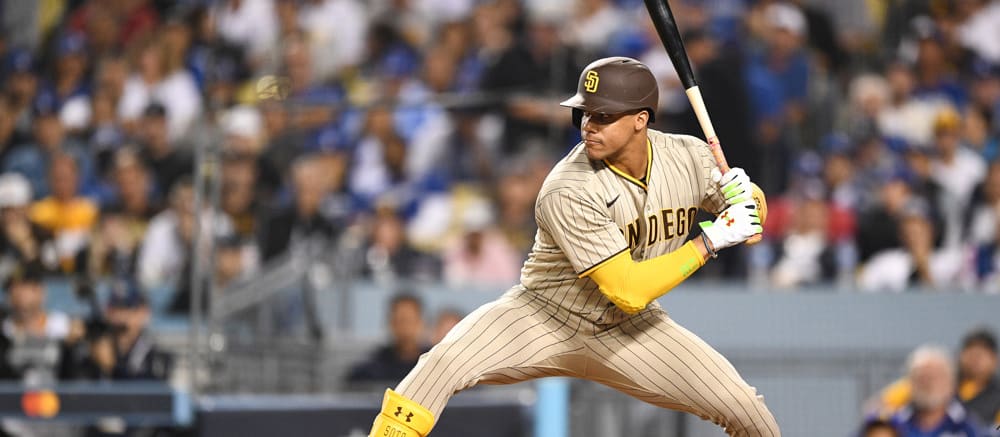Once a week (or so), the members of Tout Wars are asked to answer a question, with the replies pooled and posted on www.toutwars.com. The latest query was, "Who are you especially worried about based on their early season performance?"
Please check out Tout Table: Worrisome Starts for some great responses.
Six players garnered multiple votes, with 15 more mentioned once. What follows is a review of whether I agree or disagree with the three players garnering the most attention.
In full disclosure, the question was posed about a week ago, so there is some additional data to consider. I'll do my best to share my feelings at the time and discuss if the past week has swayed my opinion.
Manoah leading the list is no surprise, though I wonder how many would have still cited him after his seven shutout innings in Yankees Stadium on Saturday. Realistically, even the most ardent Manoah supporter had to be concerned, if only for his drop in velocity.
Prior to the outing on the 22nd, Manoah had started 35 games since the beginning of last season. His four-seam velocity from the four efforts this season ranked 13th, 22nd, 34th and 35th. Meanwhile, his two-seam landed 6th, 14th, 33rd and 34th.
To get a true perspective, it's best to compare April data from this season to the same time last year. In 2022, Manoah's April four-seam velocity ranked 5th, 8th, 13th and 29th while his two-seamer checking in as 5th,
Once a week (or so), the members of Tout Wars are asked to answer a question, with the replies pooled and posted on www.toutwars.com. The latest query was, "Who are you especially worried about based on their early season performance?"
Please check out Tout Table: Worrisome Starts for some great responses.
Six players garnered multiple votes, with 15 more mentioned once. What follows is a review of whether I agree or disagree with the three players garnering the most attention.
In full disclosure, the question was posed about a week ago, so there is some additional data to consider. I'll do my best to share my feelings at the time and discuss if the past week has swayed my opinion.
Manoah leading the list is no surprise, though I wonder how many would have still cited him after his seven shutout innings in Yankees Stadium on Saturday. Realistically, even the most ardent Manoah supporter had to be concerned, if only for his drop in velocity.
Prior to the outing on the 22nd, Manoah had started 35 games since the beginning of last season. His four-seam velocity from the four efforts this season ranked 13th, 22nd, 34th and 35th. Meanwhile, his two-seam landed 6th, 14th, 33rd and 34th.
To get a true perspective, it's best to compare April data from this season to the same time last year. In 2022, Manoah's April four-seam velocity ranked 5th, 8th, 13th and 29th while his two-seamer checking in as 5th, 16th, 20th and 35th.
They occurred, they can't be ignored, but something was clearly up with Manoah's April 5 and April 11 starts, though his worst effort was April 16 when his velocity nearly matched that from his last outing where he stifled the Yankees.
I was high on Manoah heading into the season, and remained so a week ago, but sure, I was concerned. It should be noted Manoah's lower than elite strikeout rate rightfully lowered him in other analysts' estimations, which was obviously a defensible, if not more prudent approach. As an aside, I get paid by the comma.
Slightly tangential, but still apropos to the discussion, colleague and friend Eric Cross posted this poll:
Another heat check...
ROS, pick one.
— Eric Cross (@EricCross04) April 22, 2023
I can't prove it, but I have no reason to lie. I was the first to vote and chose Manoah. In the next 24 hours, 1945 agreed with me, while 2058 went with Taj Bradley. My back of the envelope math comes up with 2058 voters being off their rocker. Honestly, I don't care if Bradley ends up outpitching Manoah, choosing the rookie is akin to predicting a dice roll to be something other than seven.
As for Saturday's outing, sure, it's encouraging, but Manoah's velocity was similar to his previous start when the Rays lit him up. Granted, Tampa Bay has, and will continue to, beat up on everybody, but it's not like the Yankees are pushovers.
Encouraged is the best word for it. Manoah is by no means out of the woods. His strikeout rate remains low, and those of us wish-casting for improvement likely have to dream on. If you were on Manoah before, hold your ground. Obviously, if you were off him, there's nowhere near enough data to change your mind.
As for the 2058 whackos preferring Bradley, he toughed it out Monday night against a tough Astros lineup, but I still think you're out of your mind.
Guilty. I was driving the McCarthy bandwagon. I even went so far as to say McCarthy could lead the majors in steals. Now he's sitting in favor of Pavin Smith.
I'll use stats through Sunday's games, which include his first (and only) home run of the season. McCarthy's expected batting average and slugging are nearly identical to last season, but the pathway is different. He's fanning less this season, but his batted ball data (average exit velocity and HardHit%) are down a tick. The result is a .167 BABIP through Sunday, as compared to a .349 last year.
There's two noteworthy points. Let's start with McCarthy's BABIP. While he isn't hitting the ball with the same authority, he's still been unlucky. He's due an uptick in hits from natural regression, but there is also a chance he starts hitting the ball harder.
Then there is the current 16.7 percent strikeout rate as compared to last season's 21.5 percent mark. Through Sunday, McCarthy amassed 66 plate appearances (PA). There are some who will note the stabilization point for strikeout rate is 60 PA, and hence contend McCarthy's improved contact is real. I used to be one of these people.
As I have written previously, this is an inaccurate application of stabilization points. The assumption is one could ascertain skills changes are reliable once the stabilization point is reached. The math is the luck-to-skill ratio for strikeout rate within 60 PA reaches 50:50. This is wrong.
The proper analysis is that the skills stabilized within that 60 PA, but it has no bearing on the ensuing 60 PA. Statistically speaking, the next 60 could be higher, lower, or the same. The level cannot be predicted from first 60. It stands to reason if a hitter continues to maintain a lower rate that there is a tangible improvement (or vice versa), but it is not predictive as soon as many suggest.
Of course, we'd all prefer to see a lower clip within the stability boundary, but it's premature to adjust rest-of-season projections. Well, it's premature to regress significantly towards the new level. Since the skill component is 50 percent, I used to average my initial strikeout rate with that after 60 PA, and call that my rest-of-season strikeout. I still regress to the stability point, but not nearly as much. It's not quite the same, but what if the numbers recorded to date occurred last season and were thus part of the initial foundation for the 2023 projection? If the player fanned less to start the season, those numbers (in our hypothetical example), would have lowered the projected strikeout rate in the spring projection.
Let's bring this back to McCarthy. I expect an improvement in batting average from regression, and there's at least a chance he maintains an improved strikeout rate. From that perspective, I'm optimistic. The problem is manager Torey Lovullo probably doesn't care about regression, or stabilization points, and just sees a guy with a .477 OPS whose primary asset is speed. As such, playing time is in jeopardy. McCarthy was in Monday's lineup, albeit batting ninth.
Early in the draft season, McCarthy was more of a luxury item in that his steals would have been a bonus, and not counted on when determining your stead in each category. However, by the end of March, McCarthy was drafted at a point his steals were expected to be part of your foundation. These folks should absolutely be concerned and look for alternate sources of steals. Other can be patient, or even drop/trade him, assuming the other stolen base contributors are coming through.
Soto is my $45 cornerstone in NL Tout Wars, so it is apparent I was confident in a rebound heading into the season. My expectation was Soto would revert to previous form, but his numbers would be hurt by Petco Park as opposed to Nationals Park. Steals were a crap shoot.
Looking at Statcast through Sunday, Soto's batted ball data was a bit confusing, mostly due to a very high ground ball rate. Veteran readers of this space likely remember I am a huge proponent of component average exit velocity. That is, I care little about average exit velocity and nothing about maximum exit velocity. Instead, it's mostly about flyball average exit velocity, since that drives power, and groundball exit velocity, since that influences BABIP. Here is some data.
Ground Ball
| Seasons | EV | HardHit% | BABIP |
|---|---|---|---|
| 2018 | 86.7 | 35.60% | 0.259 |
| 2019 | 86.6 | 36.30% | 0.266 |
| 2020 | 86.3 | 35.80% | 0.269 |
| 2021 | 89.4 | 45.40% | 0.269 |
| 2022 | 86.1 | 37.60% | 0.198 |
| 2023 | 90 | 58.80% | 0.206 |
Soto is hitting grounders much harder, but he isn't being rewarded. This is even more baffling since as a lefty swinger, Soto should benefit from the shift being regulated.
Let's be honest. Soto's low BABIP on grounders is a bummer, but he wasn't drafted to get groundball singles.
Fly Ball
| Seasons | ExVel | HardHit% | BABIP | FB Dist |
|---|---|---|---|---|
| 2018 | 98.4 | 71.40% | 0.026 | 351.6 |
| 2019 | 96.5 | 62.40% | 0.086 | 340.8 |
| 2020 | 99.1 | 66.70% | 0.143 | 363 |
| 2021 | 96.2 | 57.00% | 0.111 | 326.2 |
| 2022 | 95.9 | 58.60% | 0.109 | 324.9 |
| 2023 | 97.7 | 56.30% | 0.167 | 340.7 |
It's rare to see an increase in both groundball and flyball exit velocity. The only way it can occur is if the batter's swing isn't consistent. It's plausible for a hitter to swing differently depending on the height of the pitch, but even so, this is an intriguing combination. That said, the bottom line is when Soto lofts the ball, it's with his usual authority.
The catch is he's hitting far more grounder than usual, albeit at the expense of line drives and not flyballs.
| Seasons | LD% | GB% | FB% |
|---|---|---|---|
| 2018 | 17.50% | 53.70% | 28.80% |
| 2019 | 21.20% | 41.60% | 37.20% |
| 2020 | 19.80% | 51.60% | 28.60% |
| 2021 | 18.60% | 52.70% | 28.70% |
| 2022 | 16.20% | 47.10% | 36.80% |
| 2023 | 5.30% | 59.60% | 35.10% |
We're just over three weeks into the season and small-sample variance still applies, so my initial reaction to my fellow Touts' concern is to be happy Soto is still making solid contact and hope the line drives, and hence hits, follow. Four homers in 24 games are fine.
Then I found this super interesting analysis by The Athletic's Eno Sarris.
The book is clear. Fill the bottom of the zone against Juan Soto (left). Soto? Keeps taking those pitches (see swing map right). He needs to burn them on those low pitches somehow or this'll keep happening. pic.twitter.com/HkN5IHfSQD
— Eno Sarris (@enosarris) April 22, 2023
There were some interesting points in the replies. Many noted Soto's swing looks flatter, which is corroborated by the above tables, but I still contend he may be swinging differently on different pitches.
This is supported by many noting he's no longer going with outside pitches to hit line drives to left field, and instead turning them over with grounders to the right side. Eno also points out it appears Soto may be too selective, perhaps on low and outside pitches, since he's not comfortable driving them.
The twitter thread really helps explain the discrepancies in the data. Sure, there is still some sample size noise, but my multiple-swing theory explains the increase in exit velocity on both groundballs and flyballs, while the drop in line drives and increase in groundballs could be from Soto no longer going the other way with low and outside pitches.
This is all well and good, but it's descriptive. Can Soto revert to the batter he was with Washington? It's a crystal ball question, but Soto himself joked about the answer saying something like, "Everyone knows what I'm doing wrong, but no one can tell me how to fix it."
Maybe this is confirmation bias clouding things, but Soto is too good not to make adjustments.
Right?




































